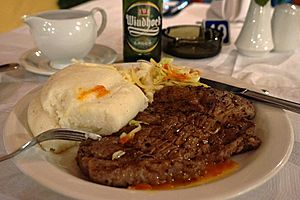Zambian cuisine facts for kids

Zambian cuisine is mostly about nshima. This is a special food made from pounded white maize. Nshima is eaten with almost every meal in Zambia. Besides nshima, Zambian food also includes different kinds of stews, cooked vegetables, and local beer. People also enjoy dried fish and even some insects!
Contents
What Zambians Eat
Main Dishes and Nshima
The most important food in Zambia is maize. Nshima is the main part of Zambian meals. It is made from white maize that has been pounded into a fine flour. People eat nshima with "relish," which means stews and vegetables. It is usually eaten with your hand, especially your right hand. Zambians eat nshima for both lunch and dinner.
You can find nshima made at home, at small food stalls, or in restaurants. In traditional villages, making nshima is a long process. It involves drying the maize, sorting the kernels, pounding them, and then cooking the flour.
Tasty Relishes
The "relish" eaten with nshima can be very simple. For example, chibwabwa is made from pumpkin leaves. Other names for these vegetable relishes are katapa, kalembula, and tente. Green vegetable relishes are often called delele or thelele.
A special way to make relish uses chidulo and kutendela. Chidulo is used for green, leafy vegetables and wild mushrooms. It is made from ashes of burnt banana leaves, bean stalks, or maize stalks. These ashes are mixed with water and strained. The liquid tastes a bit like vinegar. Kutendela is a powder made from pounded raw peanuts. It is added to the chidulo sauce for extra flavor.
Ifisashi is another popular food in Zambia. It is a type of stew made with greens and peanuts. It is also served with nshima. Ifisashi can be made without meat for vegetarians, or cooked meat can be added. Samp, which is dried corn kernels, is also eaten in Zambia.
Fish and Insects
Kapenta is a small sardine fish from Lake Tanganyika. It has been brought to other lakes in Zambia. People catch kapenta and either dry it to cook later or cook it fresh. Gizzards, which are part of a chicken, are also a popular treat in Zambia.
Some Zambians also eat various insects. These include stink bugs and mopani worms.
Traditional Drinks
In Zambia, traditional beer is made from maize. In the past, each village would brew its own special recipes. These beers were often shared during community events. Today, maize beer is also made in factories in Lusaka. Popular brands include Chibuku and Shake-Shake. Other well-known beers are Mosi and Rhino. Zambia even had its first beer festival in Lusaka on September 25, 2009.
How Zambian Food Changed
The use of maize in dishes like nsima or nshima became common in Zambia during the second half of the 1900s.
The Bemba people, who live in what is now Zambia, traditionally ate what was available based on the weather. Their meals included a thick porridge made from millet called ubwali. They ate ubwali with a "relish" called umunani. Ubwali was part of almost every meal. Umunani was usually a stew made with meat, fish, insects, or vegetables. The Bemba people preferred to eat ubwali with only one type of relish at a time. Stews with meat and vegetables were cooked with salt and sometimes ground-nuts. The Bemba generally did not eat raw food. Their cooking was usually plain, not very sour or spicy. Beer was an important part of social gatherings for the Bemba, especially during harvest times.
Like the Bemba, the Chewa people also eat a porridge called nsima. They eat it with vegetables and use it to scoop up their food.
The Tonga people of the region have traditionally eaten insects. These insects are either cooked or dried before being eaten.
See also
 In Spanish: Gastronomía de Zambia para niños
In Spanish: Gastronomía de Zambia para niños

